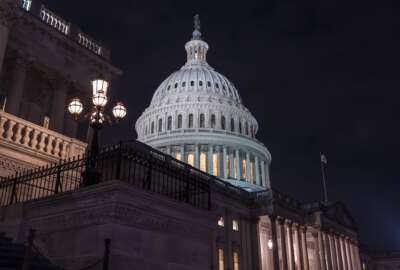OMB, agencies still crunching sequestration-related furlough numbers for non-DoD civilians
The White House released its estimate on the impact of cuts from sequestration would have on each state and the District of Columbia. OMB's Danny Werfel said they...
The White House doesn’t yet know how many non-Defense civilian employees will face furloughs if cuts from sequestration begin Friday. But Danny Werfel, the controller of the Office of Management and Budget, said they are working on it.
“Over time and as the days unfold as we approach Friday, that information will become more specifically available,” Werfel said Sunday during a conference call with reporters. “We are working with agencies actively to get the degree of specificity the Defense Department has at this point in time. We know now, for example, that 47,000 employees within the Federal Aviation Administration will be furloughed. But to get that state-by-state impact we are continuing to work on.” Friday, Ray LaHood, the secretary of the Transportation Department, said during a briefing at the White House the FAA would have fewer controllers on staff causing flight delays in major cities across the country.
“Cuts to budgets mean preventative maintenance and quick repair of runway equipment might not be possible, which could lead to more delays. And once airlines see the potential impact of these furloughs, we expect that they will change their schedules and cancel flights,” he said. “So we are beginning today discussions with our unions to likely close more than 100 air traffic control towers at airports with fewer than 150,000 flight operations per year. And we’re talking about places like Boca Raton, Fla.; Joplin, Mo.; Hilton Head, S.C.; and San Marcos, Texas. The list of the towers — the list of potential towers that are to be closed, or elimination of midnight shifts, is posted on our website as I’m speaking now. We’re also beginning discussions with unions to eliminate midnight shifts in over 60 towers across the country. The closures will impact services for commercial, general aviation and military aircraft. This will delay travelers and delay the critical goods and services that communities across the country need.”
The White House released a state-by-state breakdown on the impact sequestration cuts could have across the nation.
|
State-by-State Reports |
| Alabama | Alaska | Arizona | Arkansas | California | Colorado | Connecticut | Delaware | District of Columbia | Florida | Georgia | Hawaii | Idaho | Illinois | Indiana | Iowa | Kansas | Kentucky | Louisiana | Maine | Maryland | Massachusetts | Michigan | Minnesota | Mississippi | Missouri | Montana | Nebraska | Nevada | New Hampshire | New Jersey | New Mexico | New York | North Carolina | North Dakota | Ohio | Oklahoma | Oregon | Pennsylvania | Rhode Island | South Carolina | South Dakota | Tennessee | Texas | Utah | Vermont | Virginia | Washington | West Virginia | Wisconsin | Wyoming | |
The report highlights how the cuts would affect each of the 50 states and the District of Columbia, but the only numbers related to federal workers were civilian DoD employees.
For instance, in Washington, D.C., approximately 13,000 civilian DoD employees would be furloughed, reducing gross pay by around $111.3 million in total.
In Maryland, approximately 46,000 civilian Defense employees would be furloughed, reducing gross pay by around $353.7 million in total. Additionally, the Army would have to cut its base operation funding by about $95 million. The Air Force would have to cut funding by about $10 million and the Navy would delay about $9 million in funding for a demolition project in Patuxent River, and aircraft depot maintenance in Patuxent River could be canceled, as well as Blue Angels shows in Annapolis and Ocean City.
In Virginia, approximately 90,000 civilian DoD workers would be furloughed, reducing gross pay by around $648.4 million in total. The Army would cut base operation funding by about $146 million, while the Air Force’s funding for operations would be cut by about $8 million and the Navy would cancel the maintenance of 11 ships in Norfolk, defer four projects at Dahlgren, Oceana and Norfolk, and delay other modernization and demolition projects.
“As Deputy Secretary [Ash] Carter pointed out when he testified before the Senate Appropriations Committee, a lot of their employees that are impacted are not commuting to the Pentagon,” Werfel said. “They’re individuals all over the country: ship builders, maintenance people that are, in many cases, directly supporting military operations.”
Werfel said OMB continues to work with every agency on their sequestration implementation plan. He said there are constraints to what an agency can do to implement the $85 billion in cuts. OMB continues to emphasize to agencies that they should make cuts based on what will impact their most critical mission areas the least.
“[A]s we move into the end of the week and we approach this point if this sequestration is triggered, we will have more clarity from each agency on their operating plans. They are working through them now,” he said. “They are looking at what flexibilities, and OMB has issued guidance to agencies to look at those flexibilities like reprogramming to see if they could move money in a manner that could improve mission. We’ve come to the conclusion over and over again that these reprogramming authorities and any flexibility at agencies’ disposal are not enough to full protect mission. Therefore, as we’ve articulated time and again, all of these various disruptions and harmful impacts are going to occur. We will try to mitigate some of them and we are to the best of our ability. We are working with what we have. But … when you are taking an $85 billion cut over a seven-month period there is no roadmap of flexibility that allows you to eliminate many, many of the disruptions that are going to occur.”
House and Senate lawmakers, for their parts, have offered separate plans to avert sequestration. The House passed two bills in May and December to avert sequestration, but has not introduced a bill this session.
“If the president were serious about replacing his sequester, he’d cancel his campaign events this week and devote his schedule to pressing his Democratic-controlled Senate to finally pass something,” said a blog posted on Rep. John Boehner’s (R-Ohio), the Speaker of the House, website.
But Congress, for its part, doesn’t plan to be in session Friday when sequestration goes into effect.
RELATED STORIES:
OMB to Congress: Sequestration impact real but furloughs not immediate
OMB details widespread furloughs, cuts to agency programs under sequestration
GOP sequestration plan calls for reducing federal workforce
Copyright © 2024 Federal News Network. All rights reserved. This website is not intended for users located within the European Economic Area.
Jason Miller is executive editor of Federal News Network and directs news coverage on the people, policy and programs of the federal government.
Follow @jmillerWFED






